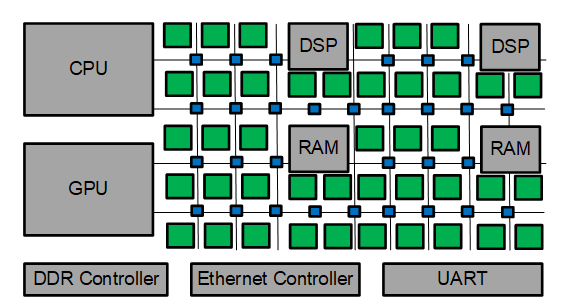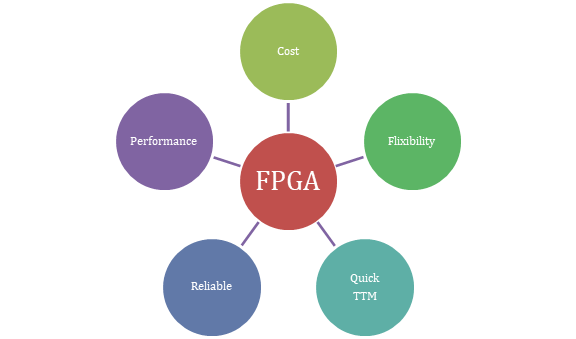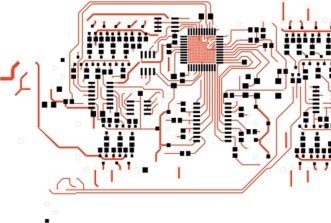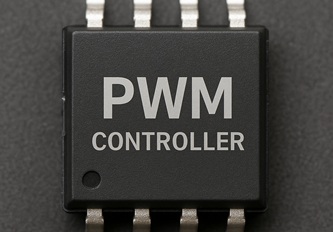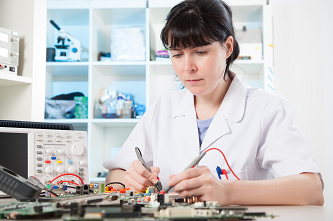FPGA in Medical and Healthcare
11/04/2025, hardwarebee
Imagine a future where medical devices not only diagnose conditions with unmatched precision but also adapt in real time to provide personalized treatments. At the heart of this cutting-edge capability are FPGAs, or Field Programmable Gate Arrays, which are swiftly revolutionizing the medical and healthcare sectors. These versatile semiconductor devices, historically developed for reprogrammable computing tasks, are increasingly being harnessed to enhance the sophistication of medical technologies.
FPGAs offer remarkable advantages such as energy efficiency, rapid data processing, and advanced imaging capabilities, which are crucial in critical healthcare scenarios. Medical applications like wearable health monitors, diagnostic equipment, and sophisticated imaging systems are utilizing these benefits to improve patient outcomes and streamline healthcare delivery. Furthermore, their integration with AI and machine learning technologies is set to advance predictive analytics, refine parameter quantization, and drive innovations across the field.
Yet, like all technologies, the adoption of FPGAs comes with its own set of challenges, from design complexities to cost and scalability issues. As the healthcare industry moves towards more personalized medicine, FPGAs hold promise in areas like drug development, rehabilitation technologies, and medical robotics. This article delves into the multifaceted role that FPGAs are playing in the medical field, the hurdles encountered, and the promising future they represent for personalized medicine and advanced healthcare solutions.
What Are FPGAs?
Field-Programmable Gate Arrays (FPGAs) are flexible, powerful circuits used to perform complex tasks. They are popular in industries like medical technology due to their adaptability. Unlike regular processors, FPGAs can be reprogrammed after they’re made. This means they can evolve with new technology and needs. In the medical field, they assist in improving patient outcomes by processing real-time data such as vital signs or medical images. These capabilities make FPGAs crucial tools in the evolution of healthcare solutions.
Definition and Basic Functions
FPGAs are special computer chips designed to be reprogrammable. Unlike traditional chips, which are used for specific tasks, FPGAs can adapt to various functions. This adaptability is why they are so valuable in many fields. In healthcare, FPGAs can manage tasks like real-time signal processing and power-controlled applications. By interpreting data effectively, they enhance devices like wearable monitors or robotic surgery tools. FPGAs’ capability to process data in real-time supports better medical diagnoses and treatments.
Historical Background and Development
FPGAs have a rich history of development that began in the 1980s. Initially created to allow easy customization of electronic circuits, they’ve evolved to handle more complex demands. Over the years, their architecture has improved, enabling them to tackle tasks once thought impossible. In medical technology, this has led to innovations in devices that monitor health and process artificial intelligence algorithms. The continued progress in FPGA design plays a vital role in enhancing the capabilities of modern medical equipment, proving indispensable in the journey of technological growth in healthcare.
Key Benefits of FPGAs in Healthcare
Field-Programmable Gate Arrays (FPGAs) have become a crucial part of modern medical technology. Their flexibility and adaptability make them ideal for various applications in the healthcare sector. FPGAs can be programmed to handle complex calculations quickly, making them perfect for real-time applications. With their FPGA-based implementations, medical devices can provide faster and more precise outcomes. This is essential for tasks like monitoring vital signs and processing data from wearable devices. Their use also extends to more advanced fields, such as robotic surgery and AI integration in medical imaging.
Energy Efficiency and Low Power Consumption
One of the standout features of FPGAs is their energy efficiency. In healthcare, devices often need to operate continuously, making low power consumption a priority. FPGAs are designed to perform tasks with minimal power usage, which is crucial for wearable devices and portable medical technology. Their ability to perform complex computations without drawing a lot of power helps extend battery life and reduce the need for frequent recharging. This efficiency is particularly beneficial in remote areas where power sources may be limited, improving patient outcomes through consistent device operation.
Real-Time Data Processing Capabilities
FPGAs excel in real-time data processing, a critical need in the medical field. Their architecture allows for faster data handling compared to traditional processors, which is vital for real-time applications. For example, when monitoring vital signs or blood pressure, speed and precision are imperative. FPGAs enable medical technology to analyze real-time signals efficiently, providing healthcare professionals with immediate and accurate results. This capability is indispensable in emergency scenarios where every second counts, ensuring prompt and effective patient care.
High-Speed Medical Imaging and Diagnostics
In medical imaging, speed and accuracy are imperative. FPGAs support high-speed processing, making them suitable for both diagnostics and real-time image analysis. They accelerate the processing of complex algorithms and can handle large amounts of data with ease. This rapid processing translates to clearer images and faster diagnostics, enhancing the capabilities of medical imaging equipment. The ability of FPGAs to work with fixed-point arithmetic and algorithmic optimizations boosts the performance of imaging systems, contributing to better patient outcomes. As a result, healthcare providers can make quick and informed decisions, improving the quality of care.
FPGAs in Medical Applications
Field-Programmable Gate Arrays (FPGAs) are reshaping medical technology with their flexible and powerful computing capabilities. In the medical field, FPGAs offer several advantages, like real-time data processing and reduced power consumption. They are key in developing efficient systems, such as wearable devices and diagnostic equipment. Furthermore, FPGAs support complex algorithms that drive innovations in robotic surgery and patient monitoring. Their role in medical applications is growing, leading to improvements in patient outcomes and healthcare delivery.
Wearable Health Monitors
Wearable health monitors are becoming essential tools for tracking vital signs. FPGAs play a significant role in these devices by enabling real-time signal processing and reducing power usage. They help in processing data from sensors that monitor health metrics like heart rate and blood pressure. FPGAs’ ability to handle Fixed-point arithmetic enhances the accuracy and reliability of these monitors. This results in better real-time applications for users who need to track their health closely.
Medical Imaging Systems
Medical imaging systems benefit from using FPGAs due to their capability for algorithmic optimizations. These systems require fast and efficient signal processing to produce high-quality images. FPGAs improve the speed and precision of these processes, leading to better diagnostic capabilities in systems, such as MRI and CT scans. Moreover, with the use of artificial intelligence and Field-Programmable Technology, FPGAs help to process and analyze images with color image enhancements. This advances the field of medical imaging, aiding healthcare professionals in providing accurate diagnoses.
Diagnostic Equipment
FPGAs are vital in the development of advanced diagnostic equipment. They allow for real-time processing, which is crucial in creating timely and accurate diagnostics. With FPGA-based implementations, diagnostic devices can achieve higher efficiency and lower power consumption, which is essential in the medical field. These advantages not only enhance Signal Processing but also improve the distribution of cipher images. The integration of FPGAs in diagnostic tools contributes to enhanced patient outcomes and more effective healthcare delivery.
Integration with Advanced Technologies
In the medical field, the integration of advanced technologies like FPGA-based systems has become essential. FPGAs, or Field-Programmable Gate Arrays, are revolutionizing healthcare by enabling real-time data processing and reducing power consumption. These systems are flexible, allowing customization for various medical applications, like monitoring vital signs or robotic surgery. FPGA technology plays a vital role in the development of wearable devices and real-time applications. These devices capture and analyze data on the go, improving patient outcomes. With their low power usage and efficient signal processing capabilities, FPGAs hold a central position in the evolution of medical technology.
AI and Machine Learning Synergy
FPGA-based systems are crucial for the synergy between AI and machine learning in healthcare. AI algorithms can be implemented efficiently using FPGAs, thanks to their reconfigurable nature. This allows for real-time processing of complex data sets, facilitating quicker and more accurate patient diagnoses. Furthermore, FPGAs support various algorithmic optimizations, which enhance the speed and accuracy of these AI models. By working together, AI and FPGAs enable healthcare professionals to make better decisions, improving overall patient experiences and outcomes. This synergy also paves the way for more personalized medicine, where treatments are tailored to individual needs.
Predictive Analytics in Healthcare
Predictive analytics in healthcare aims to foresee patient health trends and predict outcomes. By using FPGA-based implementations, medical practitioners can access real-time data, making predictions more accurate. FPGAs support complex data analysis and employ technologies like Random Forest and Fixed-point arithmetic for advanced signal processing. This capability is invaluable in predicting blood pressure trends and other vital signs, allowing for proactive medical interventions. Predictive analytics helps streamline patient management, ensuring timely care delivery and reducing hospital stay durations. The power and speed of FPGAs make predictive analytics a valuable tool in modern healthcare systems.
Enhancing Parameter Quantization
Parameter quantization is essential in managing the complexity of AI models used in medical applications. FPGAs facilitate effective parameter quantization through efficient algorithmic optimizations. This process reduces the model size, enhances processing speed, and lowers power usage, essential for wearable devices and real-time applications. By employing FPGAs for parameter quantization, healthcare technology can maintain high levels of accuracy while managing power consumption. This capability is significant in sustaining devices that require consistent, reliable operation. FPGAs’ advancements in parameter quantization contribute significantly to the evolving landscape of medical technology, ultimately improving patient outcomes across various healthcare settings.
Challenges and Limitations of FPGAs
Field-Programmable Gate Arrays (FPGAs) offer incredible versatility. They are used across various applications, including the medical field. Despite their advantages, FPGAs face several challenges that can limit their effectiveness. Their complexity, resource demands, cost, and scalability issues must be carefully managed. Understanding these limitations can help healthcare experts make informed decisions when integrating FPGAs into medical systems.
Design Constraints and Complexity
Designing FPGA-based systems can be complex and time-consuming. Engineers need specialized skills to create and optimize these systems for medical technology. Even simple tasks can become challenging due to intricate design processes. FPGAs require thorough planning and testing to meet the specific needs of real-time applications, such as vital signs monitoring. The complexity is further increased if real-time signal processing and algorithmic optimizations are involved.
FPGA designs are also constrained by their hardware. Each FPGA is different, so the medical application must match the FPGA’s specific architecture. This makes it difficult to create a one-size-fits-all solution. Diversified designs must cater to unique patient outcomes and data processing needs. This adds layers of difficulty that developers must overcome.
Resource Utilization Issues
FPGAs must manage their resources efficiently. This is particularly important in medical applications where power consumption and heat dissipation are critical. FPGAs in wearable devices, for example, need to balance power usage with performance. If not managed well, FPGAs can consume too much power, leading to overheating, which may affect the device’s reliability.
Resource allocation involves fixed-point arithmetic and memory. Signal processing tasks can demand high processing power, straining FPGA resources. As a result, there is a need for careful configuration to ensure optimal performance. Developers need to be cautious about resource distribution, especially when dealing with complex processes like real-time data processing.
Cost Factors and Scalability Concerns
The costs associated with FPGA implementation can be significant. Initial outlays for development and hardware may be high. Moreover, adapting these FPGA-based systems for new medical technologies can also involve significant costs. While they offer high flexibility, every change might require redesigning or reconfiguring the FPGA. This affects the overall cost, especially for large-scale deployments.
Scalability is another concern. FPGAs are not easily scalable compared to other technologies like ASICs. Once an FPGA system is designed and implemented, scaling it for larger applications can be challenging. The cost and time required to adapt an FPGA-based system can impede its adoption in large medical facilities. For FPGAs to become more viable in medical settings, these cost and scalability issues need to be addressed effectively.
Energy Optimization in FPGAs
Field-Programmable Gate Arrays (FPGAs) have gained traction in the medical field. They provide the flexibility needed for real-time processing and adaptability. Yet, one challenge is managing power consumption. Energy-efficient designs in FPGAs are crucial, especially for applications like wearable devices and robotic surgery. These devices need low power to maintain performance. This optimization allows medical technology to remain effective while still being energy-conscious.
Simplifying Arithmetic Operations
Arithmetic operations often require significant power, especially in FPGA-based systems. Simplifying these operations can result in better power usage. Fixed-point arithmetic is one technique used for this purpose. It reduces the complexity of real-time signal processing and real-time data processing. By simplifying these operations, FPGAs can perform complex tasks like monitoring vital signs efficiently. Algorithmic optimizations help in this simplification, ensuring that patient outcomes are not compromised while power usage is minimized.
Power-Aware Data Transmission
Data transmission is another area where power consumption can be optimized in FPGAs. Real-time applications demand quick and efficient data handling without excessive power drain. Power-aware data transmission techniques focus on reducing unnecessary data flow. This means only the most critical information, such as blood pressure readings or other vital signs, are prioritized. Efficient signal processing is achieved through careful design strategies. This approach allows wearable devices and other medical technologies to function effectively without overburdening the FPGA’s resources. By managing power use, the devices contribute to better health monitoring and patient care.
Future of FPGAs in Personalized Medicine
The field of medical technology is rapidly advancing, and FPGAs are at the forefront of this change. Field-Programmable Gate Arrays (FPGAs) are known for their flexibility and power efficiency. They are becoming key components in healthcare, offering real-time processing and robust performance. With FPGAs, medical devices can process data faster, improving patient outcomes. Personalized medicine benefits greatly from these capabilities. This approach tailors treatments to individual patients, enhancing the quality of care received. As FPGAs evolve, their role in personalized medicine will likely grow. This growth promises more precise and effective healthcare solutions in the future.
Role in Drug Development
In drug development, FPGAs are transforming how researchers analyze vast amounts of data. Their real-time signal processing abilities allow for faster and more accurate outcomes. This is crucial in testing how drugs interact with specific genetic markers. FPGAs aid in simulating these interactions promptly. This helps researchers understand potential effects and adjust treatments rapidly. The speed and efficiency FPGAs provide can accelerate drug discovery timelines. This innovation has the potential to bring life-saving medications to market faster and at lower costs. The integration of FPGAs can lead to improved drug safety and effectiveness, impacting overall patient care positively.
Impact on Rehabilitation Technologies
Rehabilitation technologies are experiencing significant advancements due to FPGAs. Their use in wearable devices is particularly noteworthy. These devices can monitor vital signs and adjust therapies in real time. For patients undergoing physical therapy, FPGAs offer a way to track progress and modify exercises as needed. This adaptability ensures that therapies remain effective over time. Moreover, FPGAs’ capabilities in consuming low power make them ideal for extended use in the medical field. Their potential to process complex signals helps in developing more responsive rehabilitation techniques. This means patients can expect faster recovery and better overall health outcomes.
Advancements in Medical Robotics and Neuroprosthetics
FPGAs play a vital role in advancements in medical robotics and neuroprosthetics. In medical robotics, they facilitate precise control and feedback, essential for tasks like robotic surgery. Their real-time data processing capabilities allow for fine movements and reduced errors. In neuroprosthetics, FPGAs provide quick data communication between the brain and artificial limbs. This results in more natural movements for patients. The adaptability of FPGAs supports algorithmic optimizations, enhancing patient outcomes further. These improvements make daily tasks easier and improve the quality of life for users. As technology evolves, the role of FPGAs in these areas will only expand, paving the way for new innovations.


